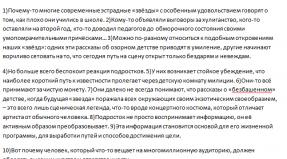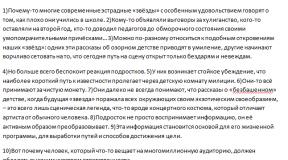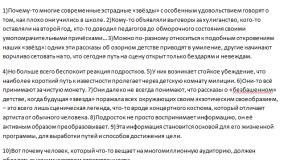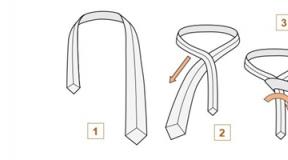Waist 80 cm. How many cm should the waist be for women and men
We continue the leptin cycle and deficit-abundance regimes, talking about visceral fat. Since body mass index and weight don't work, what should you measure? I will tell you about a number of indicators that you can measure yourself. Let's start with the waist and waist derivatives. I note that over the past decades, the average waist has been seriously spreading. The most successful waist-to-hip ratio for women is considered to be 0.7 or less. However, in the modern world this figure is closer to 0.8. It's important to understand that a larger waist doubles your risk of premature death from all causes. Every extra 5 cm around the waist increases the risk of premature death by 13% in women and 17% in men. Today we’ll talk about the waist and health, and tomorrow – about the waist and attractiveness.
So, let's measure.
We only need a measuring tape and a telephone (calculator). Yes, I remind you again that it is not excess weight in itself that is harmful, but internal (abdominal, visceral) fat. At risk are some people with a completely normal overall height-to-weight ratio, but with a large waist circumference.
I would like to draw your attention to the fact that twin studies have shown that in 22-50% of cases the ratio of waist to hip circumference can be explained by genetic factors. Among other factors, nutrition and lifestyle occupy the first places.
1. Waist circumference (centimeters).
The normal waist circumference for women is 80 centimeters (this is the upper limit, which should not be exceeded), women with a smaller circumference can only rejoice, because they have a normal weight, when the circumference ranges from 80 to 88 centimeters - this is a slight increase in weight, over 88 - obesity. For men, normal parameters are up to 94 centimeters, from 94 to 102 – weight gain, and more than 102 – a threat, that is, obesity. These people have an increased risk of dying from heart disease and cancer.
Statistics are given: men with a waist of at least 100 cm have a 50% higher mortality rate than those with a waist of less than 89 cm. In general, women with thin waists are more attractive to the opposite sex. An ideally proportioned woman should have a waist-to-hip ratio of approximately 0.7 (more precisely, between 0.60 and 0.72). The researchers gave the example of a man with a height of 178 cm. If such a person has a waist circumference of 107 cm, his life can be shortened by 1 year and 7 months. Even with normal weight, a large waist size affects life expectancy.
2. WHtR (waist-height ratio).
Waist/height ratio. The norm for this index is less than 0.5 for men and women, i.e. The waist circumference should not exceed half the person’s height.
Waist/hip ratio. Waist circumference is measured at the level of the navel. Pelvic circumference is measured at its widest point. Normally, this index is less than 0.85 for women and less than 1.0 for men. If a person has abdominal-visceral obesity, he or she has a WC/TB ratio of more than 0.85 in women and more than 1.0 in men (Stern et al., 1995). Hip circumference is measured below the greater femoral tuberosities.
According to the World Health Organization (WHO) protocol, waist circumference should be measured midway between the lower edge of the lower rib and the top of the iliac crest (the upper pelvic bone, seen from the side). A measuring tape is used for this (colloquially “centimeter”). When tightened, it should create a pressure equivalent to 100 grams. Hip circumference should be measured around the widest part of the buttocks, using the same tape, parallel to the floor.
The US National Institutes of Health and the National Health and Nutrition Examination Program use results obtained by measuring at the top of the iliac crest—essentially where we typically have the waistband of standard pants.
Often, non-professionals measure the waist at the navel level, but studies have shown that this method can often result in an understatement of its actual circumference.
When measuring both circumferences, the person should have their feet side by side, arms apart, body weight evenly distributed, and no excess clothing. Breathing should be normal, calm, and measurements should be taken at the end of exhalation. Each measurement is repeated twice, and if there is a centimeter difference between them, then the average results are taken.
In practice, in order not to delve into all these subtleties, the waist with a slender figure is most correctly measured simply in the area of its smallest circumference, as a rule, slightly above the navel. In cases where the waist is convex rather than concave, for example, as happens during pregnancy or when you are overweight, the location of the smallest circumference is often more difficult to determine. In such cases, to determine the degree of obesity, a measurement is taken a couple of centimeters above the navel. Hip circumference can be measured simply visually at the widest part of the buttocks.

Some aspects of the waist and health.
1. Character.
Women with a wider waist are characterized by “masculine behavior.” Those who read my article about visceral obesity and sex hormones remember that visceral obesity is associated with an increase in testosterone. And for men it’s the opposite. According to Cashdan, in countries where women occupy a subordinate position in economic terms (Japan, Portugal, Greece), thin waists are more common among local residents. In countries with pronounced gender equality (Denmark, Great Britain) the situation is exactly the opposite.
2. Reproductive health.
Women with thin waists enjoy better health. In addition, they are less likely to suffer from infertility and chronic diseases of the reproductive system. Therefore, a low WHR indicates good health and fertility. A recent study found that in vitro fertilization was more successful in women with a WHR of 0.70-0.79 than in women with a WHR greater than 0.80. Women who don't have a waist are more likely to have problems conceiving
Studies have shown that if the female body secretes too little estrogen, then the notorious coefficient (0.7), as a rule, exceeds the norm. And if you compare a woman whose coefficient is 0.9 with a woman whose coefficient is 0.8, then the first one is one third less likely to get pregnant. By the way, in those areas of the planet where ideas about beauty differ from the Euro-American standard, the ratio of waist to hip sizes also approaches the above-mentioned coefficient. Thus, in a number of African countries, men prefer plump women with wide hips, respectively, with sizes of 100 and 135 centimeters. And now - 100: 135 = 0.74. Be patient! The main thing is that the waist is noticeably narrower than the hips.
3. Higher mental abilities.
Research has also shown that women with large differences between their waist and hip measurements have especially sharp minds. Accordingly, the greater the difference between a woman’s hips and waist, the better her cognitive performance.
In their study, scientists examined the abilities of 16 thousand girls and adult women and came to the conclusion that more curvaceous representatives of the fair sex demonstrate better results on mental tests. The reason lies in the fatty acids that accumulate in the thighs. It is in this part of the body that the highest concentration of Omega-3 acids is observed, which improve the mental abilities of a woman during pregnancy and her unborn baby.
 |
4. Cardiovascular health.
Waist size quite reliably indicates an increased risk of hypertension, diabetes and high cholesterol. Studies have confirmed that health risks begin to increase if a woman's waist reaches 80 centimeters; at 89 centimeters it increases significantly. For men, the risk increases from 94 centimeters. Then we'll talk about adjusting for height, because
These figures are relative and are not suitable for people who are too tall or too short, children or some ethnic groups. For example, among the Japanese, the risk increases sharply if the waist size in men reaches 85 centimeters, and in women - 90 centimeters. Stroke. The risk of stroke is increased sevenfold.
5. Cancer.
A study published in the Archives of Internal Medicine found that it also increases the chances of dying from cancer, respiratory failure and other causes. After all, a large waist circumference indicates an excessive amount of fat around the abdominal organs. And this is usually associated with inflammation, high cholesterol, risk of diabetes and other problems.
The experiment by Eric J. Jacobs and his colleagues from the American Cancer Society in Atlanta involved 48.5 thousand men and 56.3 thousand women over the age of 50 years. During the study period (1997 to 2006), 9,315 men and 5,332 women from this group died.
Scientists were most surprised by the results among women. having no weight problems. It was in this category that the relationship between waist size and mortality risk was greatest. “If you're at the right weight for your height,” says Dr. Jacobs, “but your waist size is increasing and you're moving up a dress size, that's a warning sign that it's time to start eating healthier and exercising more. Even a small reduction in waist size, an inch or two, can be quite beneficial."
By measuring your waist using a tape measure, you can determine whether you are at risk. The norm is 90 cm for men and 75 cm for women. Regarding overweight people, the conclusion of American scientists is this: extra 30 cm in men and 32 cm in women doubles the risk of death. As for women with normal weight, the research results are completely stunning. Every extra 10 cm in the waist increases the likelihood of acquiring a fatal disease by about 25%.
6. Cancer in hormonal-dependent organs (breast and prostate).
The accumulation of fat deposits around the waist over a lifetime is directly linked to an increased risk of breast cancer after menopause, British researchers have found. Statistical analysis showed that the rate of increase in skirt size between 25 and 55 years of age is a clear indicator of the risk of developing the disease later in life: increasing waist circumference by one size every ten years increases this probability by 33 percent, and by two sizes increases this probability by 77 percent. .
Research shows that women whose WHR remains in the 0.7 range have optimal estrogen levels and are less susceptible to diabetes, cardiovascular disease and genital cancer. Men with a WHR of approximately 0.9 have good potency. These men have a low risk of developing prostate cancer.

7. Severity of atherosclerosis (including hidden).
Waist-to-hip ratio may be a better predictor of subclinical atherosclerosis in postmenopausal women than body mass index (BMI) or waist circumference, Korean scientists have concluded in a new study. The results of the work are presented online in the journal Maturitas. Study author Dr. Hyun Jung Lee noted that it was not possible to identify even a trend towards a statistically significant relationship between the BMI of the participants and the likelihood of them having subclinical atherosclerosis. (Remember about “healthy fat people”?). The most revealing was the ratio between waist and hip circumference. The results obtained in this work suggest that waist-to-hip ratio is a more reliable anthropometric indicator for determining the presence of subclinical atherosclerosis in the postmenopausal period.
Start, continuation here:
Waist size in men: what should it be? Many will not be able to immediately answer this question, but this indicator is extremely important for the stronger sex. After all, almost all characteristics of men’s health, including sexual health, depend on waist size.
Normal waist size for men: what should it be and why is it needed?
Waist sizes for men are not at all important from an aesthetic point of view. It's the ladies who are chasing a slender waist because it looks beautiful, elegant and feminine. For the stronger sex, the dimensions of this waist area have a completely different meaning.
But first, it’s worth understanding what the normal waistline for men is. So, the dimensions of this part of the male body should not exceed 96 centimeters. These parameters apply to people of any build, height and constitution. If the girth has long gone beyond the specified parameters, then this can threaten a person with many health problems. Which ones exactly?
A waist of more than 96 centimeters is the first step towards a disease such as obesity. Most people underestimate the harm that excess weight can have on their health. But extra pounds negatively affect many vital characteristics.
For example, the cardiovascular system suffers greatly. The heart has to work several times harder, which only wears it out further. There is also a problem with blood vessels. After all, very often excess weight is accompanied by increased cholesterol levels. And this is a terrible blow to the blood vessels; blood clots can form.
Due to excess weight, the kidneys, liver, pancreas and other internal organs suffer. A large load also falls on the human skeleton, which has to carry so much unnecessary stuff.
A waist larger than 96 centimeters means that a man inevitably has problems with male sexual performance.
 And this is a colossal blow for every representative of the stronger sex, without exception. We can confidently say that not a single man would voluntarily agree to be impotent. So why doesn't anyone think about this when acquiring fat reserves in the waist area?
And this is a colossal blow for every representative of the stronger sex, without exception. We can confidently say that not a single man would voluntarily agree to be impotent. So why doesn't anyone think about this when acquiring fat reserves in the waist area?
But do not despair, because you can easily get out of this situation. There are a few simple recommendations that will help remove all excess from the waist area in men. With diligence and a competent approach, you will soon be able to boast not only of a normal waist, but also of excellent physical shape.
What should you do to lose weight around your waist?
To achieve a normal waistline, you need to follow only two rules. You need to eat right and do some exercises and sports.
Proper nutrition is a balanced diet, which is based on healthy foods that benefit the human body. But you need to get rid of all the food that clogs it and gives the body excess calories without satisfying the feeling of hunger.
What qualifies as junk food? This is fast food, semi-finished products, instant products, everything fried, sweet, flour (it is especially harmful for men), overly salted, dried, smoked and, of course, alcohol. With such a diet, problems will be much more serious than those described above.
 Proper nutrition should include plenty of vegetables, fruits, and a moderate amount of meat (preference should be given to lean poultry). Dairy products are very important and healthy. Just don’t buy into the popular opinion that you need to eat everything low-fat. It is no less harmful than fatty foods. It is better to let this or that dairy product contain a minimum of fat, for example, 1.5 percent.
Proper nutrition should include plenty of vegetables, fruits, and a moderate amount of meat (preference should be given to lean poultry). Dairy products are very important and healthy. Just don’t buy into the popular opinion that you need to eat everything low-fat. It is no less harmful than fatty foods. It is better to let this or that dairy product contain a minimum of fat, for example, 1.5 percent.
And, of course, there is no way to have proper nutrition without grains. This is an extremely valuable product that provides the body with many useful substances and a lot of energy. Moreover, grains are very satiating, making a person full for a long time. And digestion from grains improves noticeably. It’s not for nothing that in childhood parents talk about the benefits of porridge! It turns out that the same rules are needed for adult men.
Every man should measure his waist right now and determine its size. And if a man’s waist exceeds the 96-centimeter limit, then this is the first signal that it’s time to do something about it! Let all the tips listed above help you with this! And make sure you have time for yourself.
Why is it important to measure your waist, and how does waist size affect your health? Everyone knows that excess weight affects the development of many diseases, such as diabetes, cardiovascular disease and even some types of cancer.
What are the parameters to monitor your weight and make sure you are within a healthy range. There are two simple ways. First, calculate your body mass index using a fairly simple formula. We will not dwell on this in this article. The second simple way is to measure our waist size.
Why is it important to know your waist size?
Measuring the waist circumference is the most important because we can check the amount of excess fat accumulated in the waist area. Why is this important to know?
Scientists from the World Cancer Research Center (WCRF UK) have shown that excess fatness in the abdominal area is closely associated with bowel cancer, pancreatic cancer, and breast cancer in postmenopausal women.
The following parameters are considered normal
- Women – waist size 80 cm or less
- Men – waist size 94 cm or less
As fat increases around the waist, the risk of heart disease and diabetes increases. If your measurements are greater than: women 88 cm, and men 102 cm, then you need to take action urgently! According to World Health Organization (WHO) criteria, the last two numbers correspond to a strong risk.
If your waist size exceeds these indicators, then you should pay attention to your lifestyle and adjust your diet. It may seem easier to maintain these levels at a younger age. It is extremely important to watch your waistline at any age.
Nobody warned it would be easy
To maintain your waistline, you need to follow the best recommendations for maintaining a healthy weight.
- Before going to the supermarket, plan your meals and make a list. Don't be distracted by tempting packaging. As a rule, the brighter and more attractive the picture, the more harmful the product.
- Don't go grocery shopping when you're hungry. Have a good lunch before going grocery shopping. You won't buy too much and save money.
- Keep a bowl of healthy, nutritious food on your kitchen counter that won't harm you. A bowl of apples, vegetables cut into strips. You will eat more fruits and vegetables.
- Watch your portion sizes. Look at your palm. Here is your portion size - nature took care of it itself.
- Aim for at least 30 minutes of physical activity every day. Dancing, gymnastics, gym, health walk - make friends with them!
- Stay on track! You must have a clear goal and the right motivation.
At all times, starting from antiquity, waist circumference was considered an important indicator of health and beauty.
How to measure your waist correctly
Usually the waist is measured at the narrowest point, but if this is difficult, measure the area in the middle between the bottom of the ribs and the top of the pelvic bones, this is usually at the level of the navel or slightly above. This is the point for measuring waist circumference.
The waist is measured in light clothing or bare skin.
Stand up straight and take the measurement as you exhale. There is no need to pull in your stomach too much; the exhalation should be calm.
Take a good tape measure that doesn't stretch. The centimeter should be parallel to the floor and not compress the skin. It may take some effort to achieve the perfect waist, but the results are worth it!
Men with a waist circumference of more than 100 cm relieve themselves more often, say experts from Weill Cornell Medical College (USA).
The study included 409 men aged 40 to 91 years with moderate to severe lower urinary tract symptoms who had been patients at the Bladder and Prostate Health Institute in the past two and a half years. 37.5% of the subjects had a waist circumference of less than 90 cm, 33.5% - from 90 to 99 cm, 29% - 100 cm or more. By age, participants were evenly distributed between groups; The only exception was 70–79 year olds, who turned out to be more obese than others.
It turned out that men with a wide waist urinated more often: 39% of participants from the fattest group, 27% of the “average” and 16% of those with a normal waist relieved themselves more than eight times in 24 hours. A larger waist circumference was also associated with visiting the toilet more than twice a night: 44% of obese men, 29% of those in the average group and 15% of relatively thin men experienced this. Those with a wide waist were more likely to complain of problems with erection (74.5%, 50% and 32%, respectively) and ejaculation (65%, 40% and 21%, respectively).
The same trend was observed for high blood pressure (33.5, 22 and 14.5%), coronary heart disease (29, 17 and 8%), type 2 diabetes (33, 16 and 11%) and cholesterol (254. 176 and 148 mg/dl).
With these findings, the researchers analyzed the relationship between waist size and an increased risk of a variety of urological, sexual, metabolic and cardiovascular problems. It turned out that the most obese were 39% more likely than others to encounter a problem prostate, and the likelihood of increased levels of prostate-specific antigen was 111% higher in this group than in others.
What is the normal waist size for men and women?
For adult Caucasian women, the maximum waist circumference is considered to be 80 cm. Figures in the range of 80-87 cm indicate a health risk. Anything above 88 cm is a reason to seriously think about losing weight. For men, these limits look like this: up to 94 cm is normal, 94-101 cm is a risk, more than 102 cm is a high risk.
There is, however, another way to determine how much your figure fits into a healthy framework. Moreover, compared to the “centimeter” one, it is considered more reliable - after all, what is the norm for a tall person may be too much for someone shorter. And, by the way, you don’t need any improvised means. Just stand up straight and pinch the fat fold on your stomach with two fingers. If its thickness is 2 cm or less, there is nothing to worry about. If more, start preparing for a diet.
Measuring waist circumference in men is a standard procedure for determining the amount of fat in the abdominal area. Visceral fat around the abdominal organs increases the risk of heart disease and diabetes and is therefore considered more dangerous than subcutaneous fat.
WAIST SIZE IN MEN: NORMAL
The measurement is taken at the level of the navel or at the most protruding point of the abdomen.
If a man's waist is more than 94 cm, he is at serious risk of diabetes, heart disease, cancer, stroke and erection problems. A waist circumference greater than 102 cm significantly increases the risk of the above diseases.
When men gain excess weight, fat tends to be deposited first in the waist area. It begins to accumulate around vital organs found in the abdominal cavity, such as the liver and pancreas. Excess fat has an extremely negative impact on a man's health. He is capable of:
- increase “bad” LDL cholesterol and triglycerides and decrease the amount of “good” HDL cholesterol in the blood;
- increase blood sugar and insulin levels;
- lead to insulin resistance and type 2 diabetes.
Excess body fat leads to heart attacks, heart attacks and strokes, hypertension, diabetes, cancer, osteoarthritis, and fatty liver, which are leading causes of death and disability. Exceeding the waistline is especially dangerous for men, since in women excess fat is deposited primarily not on the stomach, but in the hips and legs.
WHAT SHOULD BE THE WAIST OF MEN?
The ideal male waist size should be less than 94 cm.
Waist size for men: table
- Waist-to-hip ratio in men
The simplest self-diagnosis method that can be used at home is to determine the waist-to-hip ratio. To do this, a man needs his stomach (on an empty stomach, it is better to do this always at the same time) in a relaxed state approximately at the level of the navel. Then measure your hips at their widest point. Next you need to divide the first result by the second:
Waist (in cm) / Hips (in cm) = Ratio
If the result obtained after division is above 0.95, a man’s chances of heart attack and stroke increase. For example, a man’s waist is 80 cm, his hips are 95 cm. The ratio will be: 80 divided by 95 = 0.84 - the norm.
Your waist-to-hip ratio is a useful way to monitor your health. But many experts are turning to an even simpler technique: measuring just the waist circumference. Because this method involves one measurement instead of two, it is considered more accurate and simpler.
- Waist circumference
To correctly measure your waist circumference, a man needs to take off his shoes and stand with his feet together. The belly should be bare. Relax and exhale. It is advisable to use an unstretched soft measuring tape. You need to hold it straight, without pulling. The result obtained is recorded to the nearest millimeter.
Normally, the maximum waist size should be no more than 94 cm.
Organs and parts of the body can be of different shapes and sizes, so there is no single table for all, which would indicate the standard waist and hip sizes for men. However, there is a healthy range for weight, waist circumference and hip circumference. These numbers are used to determine the percentage of body fat and the presence of excess weight.
- Height, weight and BMI of a man
When scientists realized that it was not so much body weight that mattered, but the amount of fat, standards for assessing obesity began to change. Nevertheless, measuring body mass index (BMI) remains one of the main ways to diagnose overweight and obesity. To calculate it, weight in kg must be divided by height in meters squared. For example, a man’s weight is 80 kg, height is 175 cm. BMI = 80 / (1.75 * 1.75). The body mass index will be 26.1, which is above normal.
A BMI between 18.5 and 24.9 is considered normal. Anything above 24.9 indicates overweight. A figure below 18.5 indicates underweight.
BMI is considered to be a better measure of body fat than a test that measures the thickness of the skin on the abdomen. However, while being an official standard, the body mass index also has several disadvantages. First, athletes with a lot of muscle may have a BMI that is outside the normal range, but they will have little body fat. On the other hand, body mass index may not accurately reflect fat content in older people who have lost a significant amount of muscle mass. But the main disadvantage of the method is that BMI reflects the total volume of fat without taking into account how it is distributed in the body.
- Body mass index versus waist circumference
BMI is a more complex test, but self-measurement of the waist is often performed incorrectly. Therefore, doctors advise men to take both measurements. “BMI provides an estimate of overall body weight, and waist measurement is a good predictor of visceral abdominal fat and the risk of obesity-related diseases,” say researchers from Harvard University.
- Waist to height ratio
Men who are concerned about their heart health are also advised to calculate their waist-to-height ratio (WHTR). To do this, the abdominal circumference in cm is divided by the height in cm. This calculation provides additional information about the state of health.
A result in the range from 0.43 to 0.52 is considered normal.
According to these calculations, the average man's waist circumference should be from 76 to 91 cm. For example, if the height is 176 cm and the waist is 82, the result will be 0.46 and within the normal range (82 cm / 176 cm = 0.46).
ALLOWABLE WAIST SIZE IN MEN AND CONSEQUENCES IF IT IS EXCEEDED
Scientists from the International Agency for Research on Cancer (IARC), which is a division of the WHO, have determined that waist measurement predicts the risk of developing cancer as well as BMI. The study examined how well body mass index, abdominal circumference and waist-to-hip ratio predict the increased risk of cancer associated with obesity. The experiment lasted about 12 years, more than 40 thousand people took part in it, more than 1,600 of them were diagnosed with obesity-related cancer.
As a result, it was found that approximately 11 extra centimeters in the waist area increases the likelihood of developing obesity-related cancer by 13%. And 8 extra cm on the hips increases the risk of bowel cancer by 15%.
According to doctors, an increased risk of certain types of cancer, as well as type 2 diabetes, is observed with a waist circumference of 102 cm in men and 88 cm in women. Experts advise knowing your BMI and regularly measuring your waist circumference. “This test is easy to administer and provides insight into your potential risk for certain types of cancer, such as pancreatic or liver cancer, which are known to be associated with obesity.”
Obesity is one of the leading (after smoking) preventable causes of cancer.
How can a man reduce his waist circumference?
The main way to reduce the amount of visceral fat is to lose weight, that is, burn calories through physical activity. Sustained weight loss requires both limiting calorie intake and increasing exercise. Losing weight overall will help reduce fat in your midsection as well.
- Combating risk factors
As a man gets older, his body begins to lose muscle mass, which in turn slows down his metabolism. This can lead to increased weight and waist circumference, but making lifestyle adjustments can prevent this. Genetics may play a role in how much fat a man stores in his abdominal area. Excessive alcohol consumption can also lead to fat accumulation around the waist.
- Diet
A specialist may advise you to reduce the number of calories you consume daily, reduce portions, and replace high-calorie foods with healthier ones. For example, a doctor may recommend that a man eat fish or poultry instead of fatty red meat and increase his intake of fruits and vegetables.
- Sport
To reduce your waistline, a man needs to exercise regularly. It is important to focus on the abdominal muscles and select appropriate exercises, such as. In addition, you need to include cardio exercise, for example, or. It is advisable to exercise for at least 150 minutes per week at a moderate level of intensity, or for at least 75 minutes per week at a vigorous level. Ideally, you should aim to exercise for about 30 minutes, five days a week, on a regular basis.



















